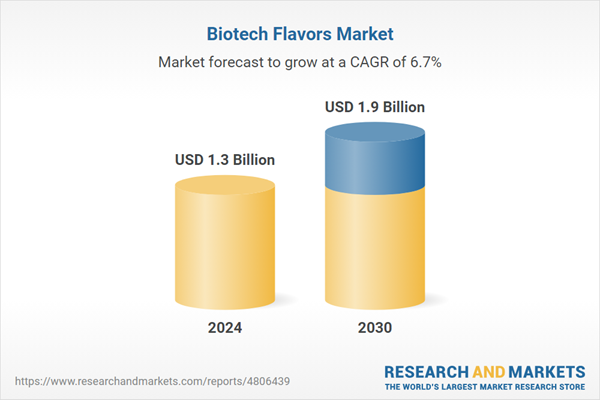The global market for Biotech Flavors was valued at US$1.3 Billion in 2024 and is projected to reach US$1.9 Billion by 2030, growing at a CAGR of 6.7% from 2024 to 2030. This comprehensive report provides an in-depth analysis of market trends, drivers, and forecasts, helping you make informed business decisions. The report includes the most recent global tariff developments and how they impact the Biotech Flavors market.
Segments: Application (Dairy Products, Beverages, Confectionery Products, Non-Dairy Ice-Cream, Bakery Products, Nutraceuticals, Other Applications); Flavor (Vanilla & Vanillin, Fruity, Other Flavors).
Geographic Regions/Countries: World; United States; Canada; Japan; China; Europe (France; Germany; Italy; United Kingdom; Spain; Russia; and Rest of Europe); Asia-Pacific (Australia; India; South Korea; and Rest of Asia-Pacific); Latin America (Argentina; Brazil; Mexico; and Rest of Latin America); Middle East (Iran; Israel; Saudi Arabia; United Arab Emirates; and Rest of Middle East); and Africa.
The analysts continuously track trade developments worldwide, drawing insights from leading global economists and over 200 industry and policy institutions, including think tanks, trade organizations, and national economic advisory bodies. This intelligence is integrated into forecasting models to provide timely, data-driven analysis of emerging risks and opportunities.
Global Biotech Flavors Market - Key Trends & Drivers Summarized
How Are Biotech Flavors Transforming the Food and Beverage Industry?
Biotech flavors are revolutionizing the food and beverage industry by providing a sustainable and innovative approach to flavor production. Unlike traditional flavors derived from natural or artificial sources, biotech flavors are produced through microbial fermentation or bioconversion, which involves using genetically modified organisms (GMOs) or enzymes to replicate the taste of natural ingredients. This method offers several advantages, including higher efficiency, consistent quality, and reduced environmental impact. As consumers increasingly demand natural and sustainable ingredients, biotech flavors are becoming a critical component for companies looking to align with health-conscious and eco-friendly trends in the market.What Are the Latest Technological Innovations in Biotech Flavor Production?
Recent technological advancements in biotech flavor production are driving significant growth and innovation in this market. The use of precision fermentation, gene editing, and synthetic biology is enabling the creation of complex and rare flavors that are otherwise difficult or costly to extract from natural sources. For instance, biotech companies are now able to produce rare flavors like vanilla and stevia in large quantities without depleting natural resources. Additionally, innovations in metabolic engineering are improving the efficiency of flavor production, reducing both the time and costs involved. These technologies are also helping manufacturers develop flavors that meet the growing demand for clean-label products, as biotech flavors can be marketed as 'natural' when derived from fermentation processes.Which Industries Are Driving the Demand for Biotech Flavors?
The primary industries driving the demand for biotech flavors include the food and beverage sector, where they are used in everything from snacks and beverages to dairy products and confectionery. As consumer preferences shift toward plant-based diets and organic products, biotech flavors are increasingly being used in plant-based meat alternatives, dairy-free products, and organic beverages. The rise of functional foods, which offer health benefits beyond basic nutrition, has also accelerated the demand for biotech flavors that enhance taste without compromising on health claims. Moreover, the cosmetics and personal care industries are tapping into biotech flavors for natural and sustainable fragrances, aligning with the broader trend toward clean beauty.What Factors Are Driving Growth?
The growth in the biotech flavors market is driven by several factors, including the increasing consumer demand for natural, sustainable, and clean-label products, as well as advancements in biotechnological processes such as fermentation and gene editing. The rising popularity of plant-based and functional foods is also contributing to the demand for innovative, naturally derived flavors. Furthermore, regulatory support for biotechnologically produced flavors as a safer alternative to artificial flavors is bolstering market growth. The increasing investment in research and development (R&D) by flavor companies and the growing trend toward personalized nutrition are expected to further propel the biotech flavors market in the coming years.Report Scope
The report analyzes the Biotech Flavors market, presented in terms of units. The analysis covers the key segments and geographic regions outlined below.Segments: Application (Dairy Products, Beverages, Confectionery Products, Non-Dairy Ice-Cream, Bakery Products, Nutraceuticals, Other Applications); Flavor (Vanilla & Vanillin, Fruity, Other Flavors).
Geographic Regions/Countries: World; United States; Canada; Japan; China; Europe (France; Germany; Italy; United Kingdom; Spain; Russia; and Rest of Europe); Asia-Pacific (Australia; India; South Korea; and Rest of Asia-Pacific); Latin America (Argentina; Brazil; Mexico; and Rest of Latin America); Middle East (Iran; Israel; Saudi Arabia; United Arab Emirates; and Rest of Middle East); and Africa.
Key Insights:
- Market Growth: Understand the significant growth trajectory of the Vanilla & Vanillin segment, which is expected to reach US$872.9 Million by 2030 with a CAGR of a 7.0%. The Fruity segment is also set to grow at 7.0% CAGR over the analysis period.
- Regional Analysis: Gain insights into the U.S. market, valued at $337.8 Million in 2024, and China, forecasted to grow at an impressive 10.9% CAGR to reach $433.7 Million by 2030. Discover growth trends in other key regions, including Japan, Canada, Germany, and the Asia-Pacific.
Why You Should Buy This Report:
- Detailed Market Analysis: Access a thorough analysis of the Global Biotech Flavors Market, covering all major geographic regions and market segments.
- Competitive Insights: Get an overview of the competitive landscape, including the market presence of major players across different geographies.
- Future Trends and Drivers: Understand the key trends and drivers shaping the future of the Global Biotech Flavors Market.
- Actionable Insights: Benefit from actionable insights that can help you identify new revenue opportunities and make strategic business decisions.
Key Questions Answered:
- How is the Global Biotech Flavors Market expected to evolve by 2030?
- What are the main drivers and restraints affecting the market?
- Which market segments will grow the most over the forecast period?
- How will market shares for different regions and segments change by 2030?
- Who are the leading players in the market, and what are their prospects?
Report Features:
- Comprehensive Market Data: Independent analysis of annual sales and market forecasts in US$ Million from 2024 to 2030.
- In-Depth Regional Analysis: Detailed insights into key markets, including the U.S., China, Japan, Canada, Europe, Asia-Pacific, Latin America, Middle East, and Africa.
- Company Profiles: Coverage of players such as Bell Flavors & Fragrances, Inc., Firmenich SA, Givaudan SA, International Flavors & Fragrances, Inc., Kerry Group Plc and more.
- Complimentary Updates: Receive free report updates for one year to keep you informed of the latest market developments.
Some of the 41 companies featured in this Biotech Flavors market report include:
- Bell Flavors & Fragrances, Inc.
- Firmenich SA
- Givaudan SA
- International Flavors & Fragrances, Inc.
- Kerry Group Plc
- Robertet SA
- Sensient Technologies Corporation
- Symrise AG
- T. Hasegawa Co., Ltd.
- Takasago International Corporation
Tariff Impact Analysis: Key Insights for 2025
Global tariff negotiations across 180+ countries are reshaping supply chains, costs, and competitiveness. This report reflects the latest developments as of April 2025 and incorporates forward-looking insights into the market outlook.The analysts continuously track trade developments worldwide, drawing insights from leading global economists and over 200 industry and policy institutions, including think tanks, trade organizations, and national economic advisory bodies. This intelligence is integrated into forecasting models to provide timely, data-driven analysis of emerging risks and opportunities.
What’s Included in This Edition:
- Tariff-adjusted market forecasts by region and segment
- Analysis of cost and supply chain implications by sourcing and trade exposure
- Strategic insights into geographic shifts
Buyers receive a free July 2025 update with:
- Finalized tariff impacts and new trade agreement effects
- Updated projections reflecting global sourcing and cost shifts
- Expanded country-specific coverage across the industry
Table of Contents
I. METHODOLOGYII. EXECUTIVE SUMMARY2. FOCUS ON SELECT PLAYERSIII. MARKET ANALYSISCANADAITALYSPAINRUSSIAREST OF EUROPESOUTH KOREAREST OF ASIA-PACIFICARGENTINABRAZILMEXICOREST OF LATIN AMERICAIRANISRAELSAUDI ARABIAUNITED ARAB EMIRATESREST OF MIDDLE EASTIV. COMPETITION
1. MARKET OVERVIEW
3. MARKET TRENDS & DRIVERS
4. GLOBAL MARKET PERSPECTIVE
UNITED STATES
JAPAN
CHINA
EUROPE
FRANCE
GERMANY
UNITED KINGDOM
ASIA-PACIFIC
AUSTRALIA
INDIA
LATIN AMERICA
MIDDLE EAST
AFRICA
Companies Mentioned (Partial List)
A selection of companies mentioned in this report includes, but is not limited to:
- Bell Flavors & Fragrances, Inc.
- Firmenich SA
- Givaudan SA
- International Flavors & Fragrances, Inc.
- Kerry Group Plc
- Robertet SA
- Sensient Technologies Corporation
- Symrise AG
- T. Hasegawa Co., Ltd.
- Takasago International Corporation
Table Information
| Report Attribute | Details |
|---|---|
| No. of Pages | 323 |
| Published | April 2025 |
| Forecast Period | 2024 - 2030 |
| Estimated Market Value ( USD | $ 1.3 Billion |
| Forecasted Market Value ( USD | $ 1.9 Billion |
| Compound Annual Growth Rate | 6.7% |
| Regions Covered | Global |









